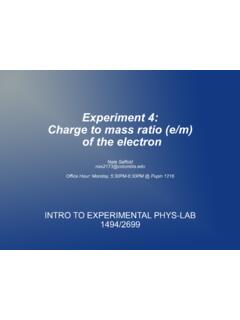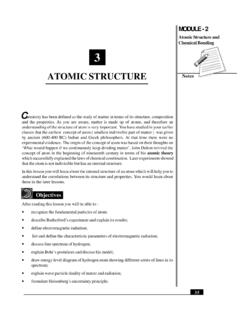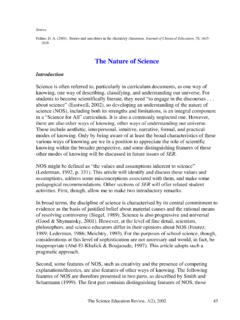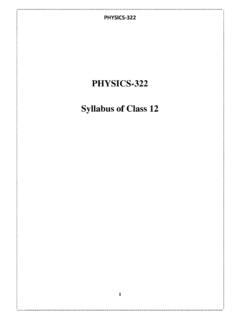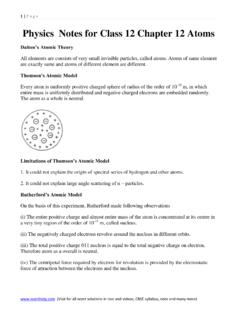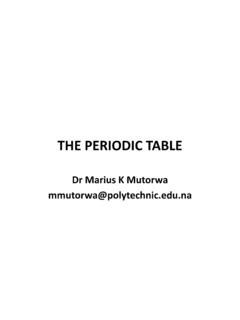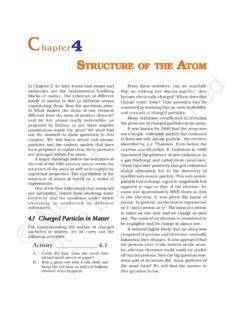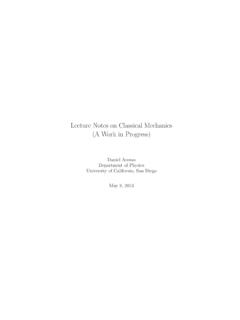Transcription of CHAPTER ONE - NCERT
1 WHAT IS PHYSICS ?Humans have always been curious about the world aroundthem. The night sky with its bright celestial objects hasfascinated humans since time immemorial. The regularrepetitions of the day and night, the annual cycle of seasons,the eclipses, the tides, the volcanoes, the rainbow have alwaysbeen a source of wonder. The world has an astonishing varietyof materials and a bewildering diversity of life and inquiring and imaginative human mind has respondedto the wonder and awe of nature in different ways. One kindof response from the earliest times has been to observe thephysical environment carefully, look for any meaningfulpatterns and relations in natural phenomena, and build anduse new tools to interact with nature.
2 This human endeavourled, in course of time, to modern science and word Science originates from the Latin verb Scientiameaning to know . The Sanskrit word Vij n and the Arabicword Ilm convey similar meaning, namely knowledge .Science, in a broad sense, is as old as human species. Theearly civilisations of Egypt, India, China, Greece, Mesopotamiaand many others made vital contributions to its the sixteenth century onwards, great strides were madein science in Europe. By the middle of the twentieth century,science had become a truly international enterprise, withmany cultures and countries contributing to its rapid is Science and what is the so-called ScientificMethod?
3 Science is a systematic attempt to understandnatural phenomena in as much detail and depth as possible,and use the knowledge so gained to predict, modify andcontrol phenomena. Science is exploring, experimenting andpredicting from what we see around us. The curiosity to learnabout the world, unravelling the secrets of nature is the firststep towards the discovery of science. The scientific methodinvolves several interconnected steps : Systematicobservations, controlled experiments, qualitative andCHAPTER ONEPHYSICAL is physics ? and excitement , technology forces of physical lawsSummaryExercises2021-22 PHYSICS2quantitative reasoning, mathematicalmodelling, prediction and verification orfalsification of theories.
4 Speculation andconjecture also have a place in science; butultimately, a scientific theory, to be acceptable,must be verified by relevant observations orexperiments. There is much philosophicaldebate about the nature and method of sciencethat we need not discuss interplay of theory and observation (orexperiment) is basic to the progress of is ever dynamic. There is no final theory in science and no unquestionedauthority among scientists. As observationsimprove in detail and precision or experimentsyield new results, theories must account forthem, if necessary, by introducing the modifications may not be drasticand may lie within the framework of existingtheory.
5 For example, when Johannes Kepler(1571-1630) examined the extensive data onplanetary motion collected by Tycho Brahe(1546-1601), the planetary circular orbits inheliocentric theory (sun at the centre of thesolar system) imagined by Nicolas Copernicus(1473 1543) had to be replaced by ellipticalorbits to fit the data better. Occasionally,however, the existing theory is simply unableto explain new observations. This causes amajor upheaval in science. In the beginning ofthe twentieth century, it was realised thatNewtonian mechanics, till then a verysuccessful theory, could not explain some of themost basic features of atomic , the then accepted wave picture of lightfailed to explain the photoelectric effect led to the development of a radically newtheory (Quantum Mechanics) to deal with atomicand molecular as a new experiment may suggest analternative theoretical model, a theoreticaladvance may suggest what to look for in someexperiments.
6 The result of experiment ofscattering of alpha particles by gold foil, in 1911by Ernest rutherford (1871 1937) establishedthe nuclear model of the atom, which thenbecame the basis of the quantum theory ofhydrogen atom given in 1913 by Niels Bohr(1885 1962). On the other hand, the concept ofantiparticle was first introduced theoretically byPaul Dirac (1902 1984) in 1930 and confirmedtwo years later by the experimental discovery ofpositron (antielectron) by Carl is a basic discipline in the categoryof Natural Sciences, which also includes otherdisciplines like Chemistry and Biology.
7 The wordPhysics comes from a Greek word meaningnature. Its Sanskrit equivalent is Bhautiki thatis used to refer to the study of the physical precise definition of this discipline is neitherpossible nor necessary. We can broadly describephysics as a study of the basic laws of natureand their manifestation in different naturalphenomena. The scope of physics is describedbriefly in the next section. Here we remark ontwo principal thrusts in physics : unificationand Physics, we attempt to explain diversephysical phenomena in terms of a few conceptsand laws. The effort is to see the physical worldas manifestation of some universal laws indifferent domains and conditions.
8 For example,the same law of gravitation (given by Newton)describes the fall of an apple to the ground, themotion of the moon around the earth and themotion of planets around the sun. Similarly, thebasic laws of electromagnetism (Maxwell sequations) govern all electric and magneticphenomena. The attempts to unify fundamentalforces of nature (section ) reflect this samequest for related effort is to derive the properties of abigger, more complex, system from the propertiesand interactions of its constituent simpler approach is called reductionism and isat the heart of physics.
9 For example, the subjectof thermodynamics, developed in the nineteenthcentury, deals with bulk systems in terms ofmacroscopic quantities such as temperature,internal energy, entropy, etc. Subsequently, thesubjects of kinetic theory and statisticalmechanics interpreted these quantities in termsof the properties of the molecular constituentsof the bulk system. In particular, thetemperature was seen to be related to the averagekinetic energy of molecules of the SCOPE AND EXCITEMENT OF PHYSICSWe can get some idea of the scope of physics bylooking at its various sub-disciplines.
10 Basically,there are two domains of interest : macroscopicand microscopic. The macroscopic domainincludes phenomena at the laboratory, terrestrialand astronomical scales. The microscopic domainincludes atomic, molecular and nuclear2021-22 PHYSICAL WORLD3 Ampere and Faraday, and encapsulated byMaxwell in his famous set of equations. Themotion of a current-carrying conductor in amagnetic field, the response of a circuit to an acvoltage (signal), the working of an antenna, thepropagation of radio waves in the ionosphere, etc.,are problems of electrodynamics.










